Origins
Analysis
Scholarship
Adaptations
Origins
The Shoes That Were Danced To Pieces (Germany)
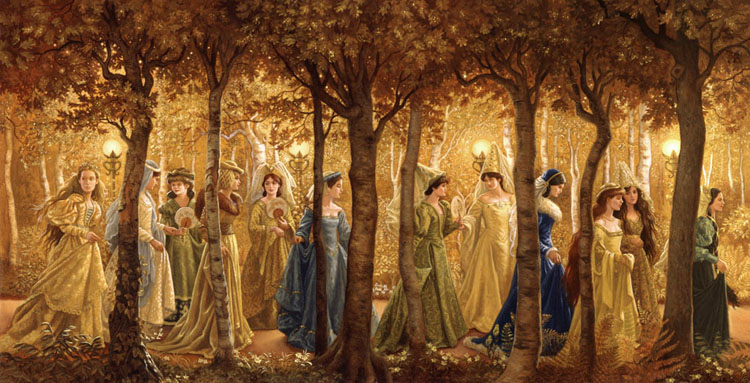
The Grimms Brothers are credited with the original publication of this tale in 1812, but there are variants of this story from many countries all over the world. In the Grimms version, there is a king who has twelve daughters who dance through their shoes each night. The king offers his kingdom and marriage to one of his daughters in exchange for the solved mystery of where his daughters go each night. The punishment for not discovering is death. An old woman aids a poor soldier by telling him not to drink the wine the princesses give him and she gives him an invisibility cloak in order to follow the princesses undetected. The soldier indeed follows the princesses and plucks a branch from the silver trees, the gold trees and the diamond trees. He sees the princesses dance with the princes in the underground castle, and reveals their secret to their father, the king. The poor soldiers marries the oldest princess and inherits the kingdom upon the king’s death.
The Princess with the Twelve Pair of Golden Shoes (Denmark)
In this Danish version, there is only one princess and she dances through twelve golden shoes. A maiden clad in white assists the princess escape to the underground world where the princess is cursed to dance with an ugly troll. In the end, the young man discovers her secret by raising an invisibility stick in front of his face and following her down. He stabs the evil troll with a needle and with each drop of blood he lets fall, the trees, flowers, and grasses turn into men, women and children who had also been under the ugly troll’s curse.
The Invisible Shepherd Boy (Hungary)
In the Hungarian version, the king has twelve daughters, but only eleven wear out shoes each night. A poor man embarks on the journey to figure out what is happening with the help of a bag that can never be filled and an invisibility pelt from Saint Peter. The eleven daughters are awoken each night by a spirit who gives them a potion which they rub on their shoulders and grow wings. They dance with fairy princes and wear out many pairs of shoes. When the poor man reveals their secret, he marries the youngest princess who wasn’t involved in the dancing and the eleven others are burned to death as sorceresses.
The Midnight Dance (Russia)

This Russian tale is rather similar to the Grimms’ but without the punishment of death if the men can’t solve the mystery, only imprisonment. The underground kingdom is also the realm of the Accursed Tsar instead of just a magical place. When the poor man reveals the princesses’ secret, the king blocks the entrance to the Tsar’s realm so that no one can enter it again and the poor man marries the youngest daughter.
The Three Girls (Gypsy [Slovak, Moravian and Bohemian])
In this Gypsy variant, the king has three daughters and the man who determines to discover where they go each night has the name of Jankos who is assisted by a fairy named Halenka. It is revealed that each night the daughters go down to hell with three devils. They dance with the devils and then two of them lay with the devils. When Jankos reveals this to the king, the king shoots the two daughters who laid with the devils and slits open their bellies to reveal many little devils who are scattered. After a complicated process of burying them in a church, laying a coffin in front of each altar, and many soldiers standing watch over them, the daughters are alive and well again and Jankos marries one of them.
The Seven Iron Slippers (Portugal)
In this Portuguese variant, the soldier earns the magical objects by outwitting others instead of simply asking for them like in other variants. Also, the king has only one daughter who wears out seven pairs of slippers made of iron each night. When the soldier follows the princess, she doesn’t enter a magical realm below, instead she rides in a carriage and a vessel across the sea. She must pass three giants who are sentinels by stating her name as the Princess of Harmony and finally arrives at a beautiful palace where she dances with her lover, a giant. The soldier reveals the princess’s secret and the two are married.
The Twelve Dancing Princesses (France)
The French variant has the most detail and character development of all the other variants. The story focuses on the boy whose name is Michael but nicknamed Star Gazer because he liked to stare at the stars. He yearns to meet and be married to a woman who has a white neck, small hands and dresses in silk and lace. Star Gazer receives his help through a lady dressed in gold who appears to him in his dreams. Instead of immediately trying to solve the mystery of where the twelve princesses were going each night to ruin their slippers, Star Gazer offers his services at the castle and he becomes the gardener. The lady in gold helps him by providing him with an invisibility flower and Star Gazer follows the princesses and hides branches from the magical world in the youngest princess’s bouquet. The youngest princess, Lina, and Star Gazer develop feelings for each other at a distance and finally all of the princesses invite Star Gazer to come down to the magical world without his invisibility. Star Gazer goes and knows that the drink he is offered down there will enchant him to stay there forever. But he is willing to do it in order to dance with Lina. At the last second, Lina stops Star Gazer from drinking by professing, “Don’t drink! I would rather marry a gardener.” The story ends happily ever after with Star Gazer becoming a prince and marrying Lina.
Dorani (Punjab)

This Punjabi variant begins with a prince discovering the golden hair of a mysterious girl and in a Cinderella type quest, he searches high and low for the girl whose hair it is and swears he will marry her when he finds her. He finds the owner, Dorani, who he marries but only under the condition set by her father that every night she must return to her old home. Dorani never speaks to the prince, but the prince allows her to return home each night. Finally, he gets frustrated and through a magical substance he sprinkles on himself, he becomes invisible and follows his wife. He discovers that his wife has been cursed to fly through the air on a stool each night to a palace and dance and has been forbidden to speak or tell anyone about it. The prince is able to rescue his wife through the power of love and they have a beautiful marriage.
Hildur, the Queen of Elves (Iceland)

In this Icelandic variant, the story is told of a farmer with a housekeeper named Hildur. The problem is that every morning on Christmas day, their herdsman is found dead in his bed. Finally, one herdsman stays awake during the night before Christmas and discovers Hildur’s secret identity. She is the the queen of the elves and is only allowed to visit her husband and kids once a year due to the disapproval of her mother-in-law. In order to visit them, she must ride a man with a magical bridle to Elf-Land which literally breaks the man’s heart. However, the curse is broken when the brave herdsman survives and is able to reveal her secret. Hildur is allowed to return to her family and the herdsman lives a prosperous life.
Analysis
In the Grimm’s Brother’s version of The Worn-Out Dancing Shoes, the reader enters a classic fairytale world of kings, princesses, and a problem to be solved. The king faces the problem of his daughters’ shoes being worn out every single night and seeks to find a solution. The reward of the throne and marriage to one of the daughters is offered to the man who can discover the reason for the worn out shoes. At first glance, this story is a rather typical fairytale of problem solving, grand adventures, and royal families. But as one reads closely and examines the characters of the soldier, the king, and the princesses, this tale begs the question of who is the hero of this story? According to Propp’s structure of a fairytale, a hero and a villain is required. However, as one reads this story, it can be unclear who the hero is and who the villain is.
The king’s invitation is for anyone to come to the castle and discover where his daughters danced during the night. His reward is the throne and a daughter. His consequence of not discovering the location after three nights is death. Already with this invitation, the king is placing the throne and his daughters at the same level and it seems as though most of the men that come are mostly in it for the throne. Even the soldier says, “I’d certainly like to find out where the king’s daughters go dancing and where they wear out their shoes so I could become king.” Even at the end of the story, the reward of a princess as a wife seems as though it is an after thought. The soldier seems as though he isn’t even sure if he wants one of the princesses as his wife and grudgingly takes the oldest princess. So although the soldier solves the mystery and wins in the end, is he really the hero? He seemingly does it all for the throne and ends the princesses’ quest in rescuing their princes.
The king’s desire to figure out what happens to his daughters each night seems to come from a place of love and protection at a first glance. Why else would he go to such lengths to discover where his daughters disappear to? Unless this obsession with solving the mystery comes from a place of power and control. This obsession is made clear through his strict rules and consequences of the competition: “Whoever could find out where his daughters danced during the night could choose one of them for his wife and be king after his death. But anyone who came and failed to uncover everything after three days and nights would lose his life.” This extreme consequence of death only intensifies the power that he holds as king as he executes many princes and other men who try. When their secret is revealed, any independence or freedom that the princess previously had is gone forever. And it is not just their freedom that is taken away but the freedom of the cursed princes. So although the king desires to discover the princess’s’ secret and offers tempting rewards, he takes away the freedom of many as he does so.
The reader hardly learns anything about the twelve princesses and their backstory. All that is revealed to the reader is what the king knows: the evidence of the worn-out shoes found every morning. The reader learns along with the soldier as he discovers the secret underground palace. The twelve sisters are generally lumped into one group of princesses, except for the youngest and the oldest. The youngest is portrayed as the timid, cautious, and naive one, while the oldest is portrayed as the bold, confident, and powerful one. It is never explained the details of the curse over the princes that they dance with every night, but it can be assumed that the princesses are entering the underground palace each night in order to dance with the princes and break a curse placed on them. This love they have for these mysterious princes is more powerful than a desire they could have to spare the lives of the many men who come to solve the mystery of their worn-out shoes. In that light, the princesses can be seen as the villains for allowing the men to be executed instead of revealing their secret. However, it seems as though their freedom and the freedom of people they love were at stake.
In the end, it isn’t the princesses who win. The king wins because he discovers where his daughters have been going each night and the soldier wins because he gets the throne. However, the princesses lose their freedom and their princes’ freedom. In Propp’s structure of a fairy tale, the hero should be rewarded at the end and the villain should be punished. So according to this structure, the soldier and the king are the heroes while the princesses are the villains. However, there is enough evidence for and against each of these characters to argue that any of them could be both the hero and villain.
Scholarship
Feminism and Fairy Tales by Karen E. Rowe
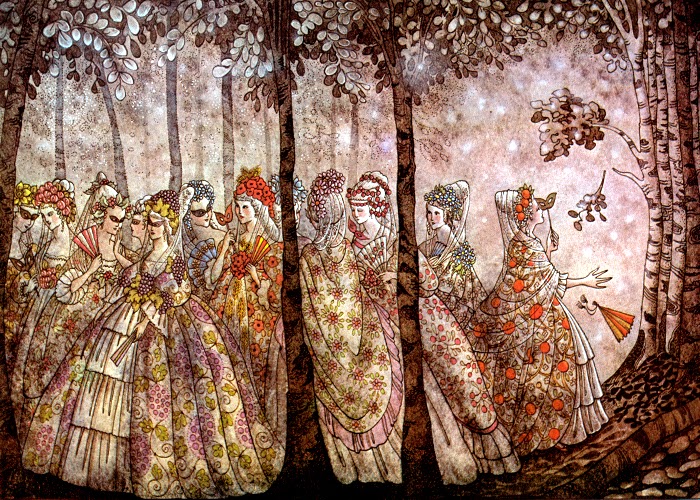
“Not designed to stimulate unilateral actions by aggressive, self-motivated women, romantic tales provide few alternative models for female behavior without criticizing their power. The unfortunate heroines of “The Twelve Dancing Princesses” initially elude marriage by drugging suitors and magically retreating at night to dance with dream princes in an underground kingdom. Apparently unwilling to forgo romantic fantasies for realistic marriages, the twelve princesses are eventually foiled by a clever soldier, who promptly claims the eldest as reward.”
Symbolic Sex-Role Reversals in the Grimms’ Fairy Tales by D.L. Ashliman
“The household fairy tale—told primarily by women—provides a vehicle for the expression of forbidden desires. This vehicle, created and steered by females storytellers, carries teller and listener alike into a realm where women enjoy the same sexual freedoms that men have in the everyday world. They can create a make-believe world where problems like the inability to correct the sexism in their lives would find a fantastic solution at least temporarily.”
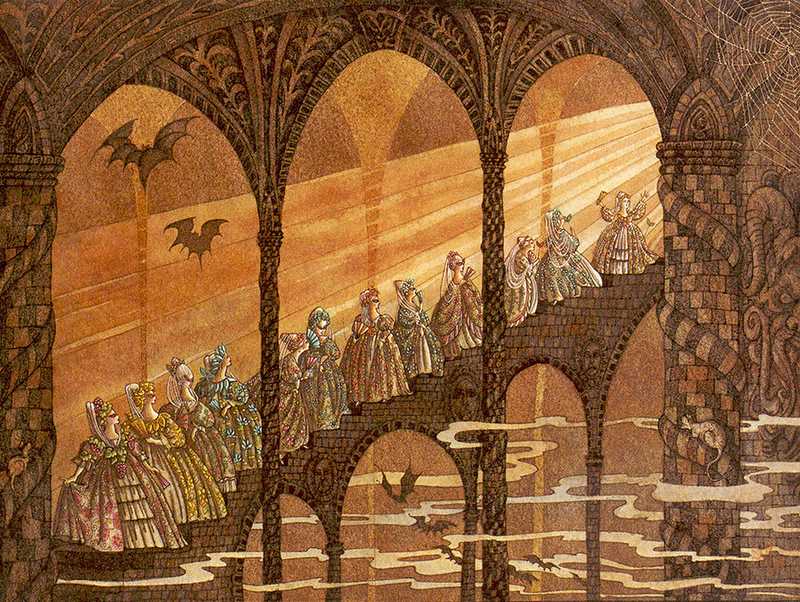
“To appreciate why the good king was so upset about the violation of his daughter’s shoes, it is necessary to understand a symbolic convention in European folklore so deeply rooted and so widespread that most tellers and hearers of this story must have perceived, at one level of consciousness or another, that this was a story about an activity much more severely prohibited than dancing in the night. This convention is the very frequent use of the shoe in European folk customs and literature to symbolically represent the female genitalia”
Worn Shoes: Identity, Memory and Footwear by Jenny Hockey, Rachel Dilley, Victoria Robinson and Alexandra
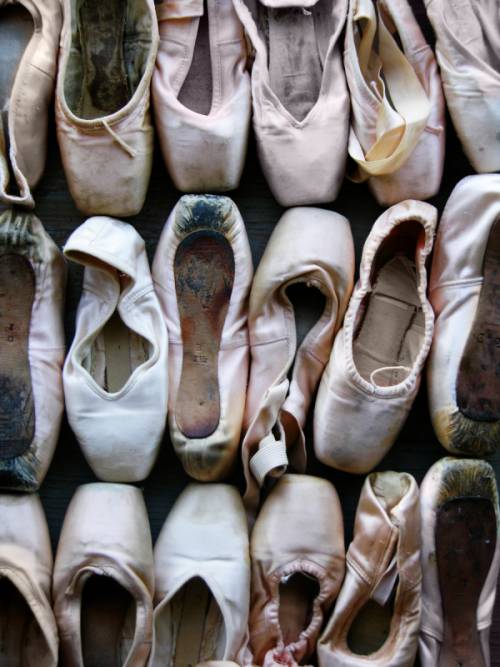
“Shoes are thus being ascribed the capacity to transcend the functional and even the fashionable – to have implications for identity itself. Through the skills of designers and advertisers, they are seen to achieve symbolic efficacy and transformative, even magical powers. Viewed from this perspective, shoes might seem to be having a ‘moment’, one that is commonly associated with women. Yet within European popular culture a long tradition of story-telling has foregrounded the potency of footwear in relation to both male and female characters. Examples include the seven league boots that aggrandise Puss-in-Boots; Cinderella’s glass slippers; the elf-stitched shoes that transform the cobbler’s fortunes; the red shoes that promise to dance Hans Christian Andersen’s Karen out of poverty; the worn-out shoes of The Twelve Dancing Princesses which lead their suitors to either death or a throne; the shoemaker Leprechauns who conceal pots of gold; the red-hot shoes that kill Snow White’s stepmother. In twentieth century popular culture, Dorothy’s ruby slippers transport her home in The Wizard of Oz, in UK boys’ comics, Billy Dane scores in his magic football boots, and more recently, in the film Like Mike (2002), a 14-year-old orphan becomes a National Basketball Association superstar after trying on a pair of sneakers with the faded initials MJ inside, a theme that draws on the magic basketball boots seen in the video Slam Dunk Ernest (1995). Examples from the last 50 years of pop music also show footwear marking a transition or assuming a pivotal role within a relationship: the Everley Brothers’ ‘Put my little shoes away’; Carl Perkins’ ‘Blue Suede Shoes’; Nancy Sinatra’s ‘These boots are made for walking’; Depeche Mode’s ‘Walking in My Shoes; Kate Bush’s ‘The Red Shoes’; and Paolo Nutini’s ‘New Shoes’.”
Forever Acting Alone: The Absence of Female Collaboration in Grimms’ Fairy Tales by Michael Mendelson
“More precisely, I am concerned that the absence of female collaboration in Grimms’ Fairy Tales serves to substantiate the notion that there is something somehow threatening in the very idea of women working together, an idea which seems to be at work in Grimms’ but which has no place in any contemporary milieu. Such complexity is also a feature of those few tales in the collection that do concentrate on women working together. I would place three of the two-hundred tales in this quasi-collaborative category, including “Fichter’s Bird,” “Snow White and Rose Red,” and “The Worn-Out Dancing Shoes.” The sense of identity between seemingly distinct individuals is also at play in “The Worn-Out Dancing Shoes,” a variation on the classic tale of “The Twelve Dancing Princesses.” In Grimms’, the twelve sisters do cooperate to both indulge in and hide their late-night forays to an underground palace. But whereas in the “Six Servants” each of the male colleagues brings a unique skill to the adventures and operates as a distinct individual working toward the common good, these twelve princesses remain almost entirely undifferentiated. Moreover, the princesses are not exactly a positive social force, since their collective dalliance leads to the beheading of many suitors; though, in truth, their deviance is forced upon them by a father who would control their lives and passions. Again, however, female collaboration as portrayed by the Grimms is problematic and potentially criminal. Nonetheless, this scant group of three tales is the epitome of female cooperation in the Grimms’ collection, an attribution that may, in the end, serve only to highlight the scarcity of real community among the females of the Kinder und Hausmarchen.”
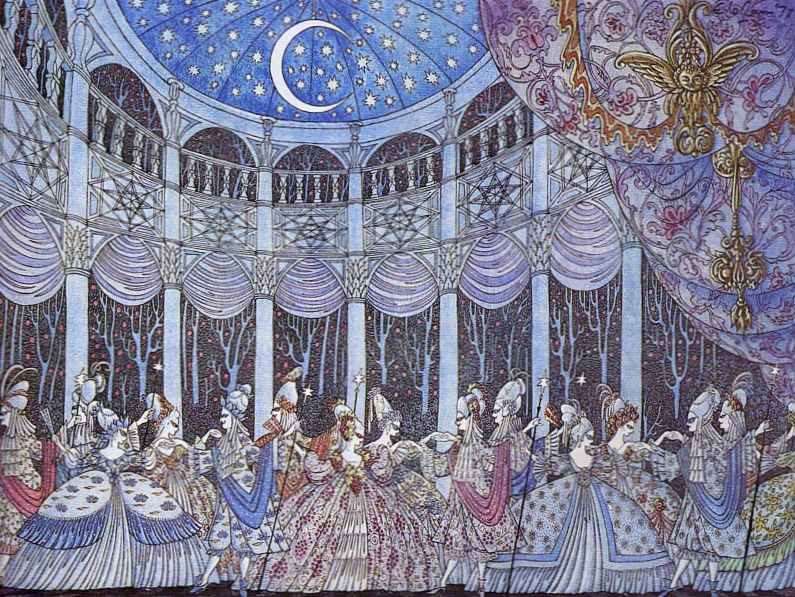
“It is not, however, common within the women’s tales. “The Worn-Out Dancing Shoes” and “The Twelve Huntsmen” stand as dominant cases, but neither displays the collective effort or the mutual benefits of their counterparts within the male canon. In the former tale, the emphasis is really on the valiant soldier who outwits the twelve women. There is almost no differentiation among these twelve sisters, they don’t ever work together as a group, and there is no shared accomplishment. In the latter, the situation is the same: the identical heroines never act independently and there is no shared benefit. Indeed the eleven look-a-like huntresses are simply forgotten in the end.”
Undermining a Grimm Tale: A Feminist Reading of “The Worn-Out Dancing Shoes” by Hayley S. Thomas
“The end of the tale does manage to avoid the cloud of degradation which has inevitably surrounded other immodest women, even if its teleological impulse demands the usurpation of her/their powers. It seems to me that the soldier’s own disfigured status, in addition to the very representation of a subaltern space (as well as the time spent there by all except the old woman and the king, who represent the reification of the fairy-tale archetype), mitigates against, if not completely disrupts the (re)acquisition of (wo)manliness that takes place above ground at the end of the tale. Nevertheless, there is a lesson in the fact that the soldier does win, and that he inherits the kingdom while the other princes remain enchanted and in the dark. His victory re-inscribes the notion that commodity exchange/mediation between men for the bodies of women is a crucial aspect in both male and female careers in the Grimms’ fairy tales.”
“On the one hand, the traditional fairy tale and the male career marchen in particular suggest that the community good is best served by constraining woman’s nature within the marketplace through male exchange of power. This is accomplished by the literal and figurative trafficking of women’s bodies through marriage. At the end of the tale, obliged to marry the soldier “that same day” (Grimm 473), the eldest daughter is textually re-inscribed in terms of her “use- value for man, an exchange value among men; in other words, a commodity [ . . . and] locus of a more or less competitive exchange between two men […]” (Irigaray 31-32). Of course, one of the many ironies of patriarchy is the fact that although marriage (anď consequently, bearing children) is the ultimate fulfillment of womanhood, she [the woman] cannot openly market herself.
Adaptations
Entwined by Heather Dixon

In this young-adult novel, author Heather Dixon retells and adapts the story of The Twelve Dancing Princesses from the perspective of the oldest of the twelve sisters, Azalea. When Azalea’s mother dies in childbirth, Azalea is entrusted with the responsibility to take care of and raise her younger sisters after her father, the king, goes off to war. However, with the proper mourning period after the queen’s death, dancing is strictly prohibited. Through magical means, they discover a kingdom underneath the castle where a Keeper makes a deal with them, allowing them to come dance there every single night. However, slowly it is revealed that the Keeper isn’t so agreeable and kind after all when he begins to steal things from the princesses and require them to do things to get it back. Meanwhile, the king begins to recruit men to figure out where the princesses are going each night. In the end, the princesses are able to defeat the evil Keeper with the help and rescue of the male characters in the story. One of the men that helped throughout the story, Mr. Bradford, falls in love with Azalea with him and everything works out so that they can marry. Learn more or buy book here.
This adaptation takes the perspective of one of the sisters which is a refreshing change from all the variants which are told from the perspective of the boy. Not only does the reader get to know Azalea specifically, but the reader is given the name and multiple personality traits of each sister. It is quite clear that Azalea and her sisters are the protagonists in this story and that the Keeper is the villain. As the Princess Royal, Azalea has a large responsibility and has simply accepted that she will be forced into an arranged marriage by her father and parliament. It is very clear in this retelling that the underground palace (in the beginning) serves as an escape from this oppression and the prohibition of dancing. However, in the end, the underground palace becomes a prison and the real world becomes a place with love and freedom. Azalea is ultimately able to fight back against expectations, marry the man she wants and dance with her whole family.
Brothers of the Knight by Debbie Allen, Pictures by Kadir Nelson
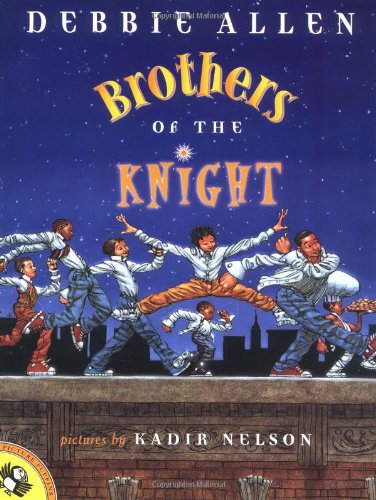
In this children’s picture book, author Debbie Allen adapts the Grimms’ fairy tale to Harlem with a father who has twelve sons. Every morning the sons’ shoes were torn to shreds and the father couldn’t find a housekeeper who would prevent it. Finally he finds a housekeeper named Sunday who keeps the house clean and is able to follow the sons during the night with an invisibility scarf. The sons crawl through a secret doorway in their bed and dance across down to the Big Band Ballroom where they swing the whole night. When the father is told what happens each night, he reveals that he used to be the best dancer at the Sock Hop. The whole family can dance together at the end of the story and the father and Sunday end up getting married. Learn more or buy book here.
This adaptation is a modern, hip retelling of the classic fairy tale that is mainly due to the setting and time period change. By setting this in a more modern time period and in New York, the feeling of the story automatically changes. The sons are scared of telling their father about their love of dancing, so they hide it from him which causes even more grief to the father than the truth would. As a children’s book, it has a fairly clear and simple moral of truth telling. Everything is better in the end when everyone tells the truth. The sons confess their nightly escapades and the father confesses his secret love of dancing and his love for Sunday, and everyone really truly does live happily ever after.
The Princesses Have a Ball by Teresa Bateman, Illustrated by Lynne Cravath
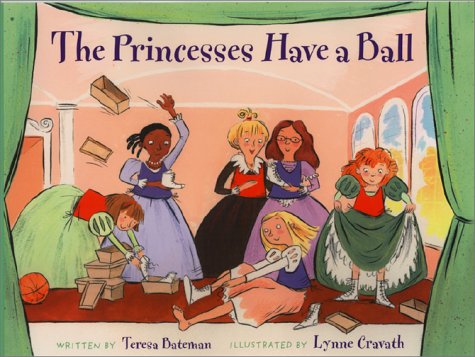
This retelling flips a reader’s expectations on its head when it comes to how a proper princess should behave. The king indeed has twelve daughters and they do destroy their shoes each night in a mysterious way and the king is forced to buy new shoes for them every single day. The cobbler, Jack, is the one who has the first suspicions of what the princesses are up to. It is clear to him that the destroyed shoes are worn out athletically and so he follows them one night down a large staircase that leads below the castle. He discovers the princesses playing a game of basketball! Instead of revealing their secret right away, Jack makes shoes that are better fit to withstand basketball playing with a rubber sole, a high-topped edge, arch support and sturdy laces. Jack convinces them to tell their father, so the princesses ask their father for permission to plan a ball and the princesses have a basketball game instead with all the guest cheering them on. The king, of course, loves it and becomes the referee as the princesses play basketball every day! Learn more or buy book here.
This adaptation is not what you may expect because there is no dancing involved. It breaks those expectations by claiming that princesses, or any girl for that matter, can play basketball or really do anything they want. Cultural expectations don’t matter if it is what you love to do. These princesses are ashamed of their basketball talents at first, but in the end it becomes a means of unification. The man who discovers their secret, doesn’t even come into the end of the story as a love interest. He simply solves the mystery and helps the princesses with better shoes. This focuses the story and the moral of it onto the princesses and what they learned about being true to themselves.
Barbie in the Twelve Dancing Princesses
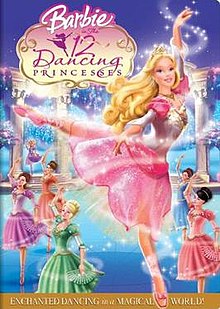
In this animated Barbie movie, the twelve princesses discover the underground kingdom as an escape from their evil aunt who has taken over the kingdom and forced the princesses to be proper instead of having fun. They choose to go to the dancing kingdom each night because they love it and they feel connected to their dead mother. They don’t dance with princes but with each other and grow closer together. The cobbler helps defeat the evil aunt and the love that he and Genevieve (Barbie) have for each other end up saving them all. This movie is a fun children’s movie that encourages its viewers to have fun and chase their dreams. It is clear in this film that the evil aunt is the villain and everyone else are the heroes. The princesses have individual personalities and identities, and they seem independent and confident in their abilities. Learn more or watch movie here.
“The Twelve Dancing Princesses” by Anne Sexton

In this creative poetic retelling of this tale in poet Anne Sexton’s book Transformations, Sexton starts off her poem with the question, “If you danced from midnight to six A.M. who would understand?” She tells us about the people that understand the feeling of staying awake from midnight to 6 am like the runaway boy, the paralytic’s wife, the passengers from Boston to Paris, the amnesiac, the drunken poet, the insomniac, and the night nurse. Sexton then presents the story of the twelve dancing princesses, while incorporating references to Mickey Finn, Andy Gump, Miss America, Tinkerbell, and the Sphinx. In the end, Sexton makes it clear who is the winner and the loser in this tale. She says,
“He had won. The dancing shoes would dance
no more. The princesses were torn from
their night life like a baby from its pacifier.
Because he was old he picked the eldest.
At the wedding the princesses averted their eyes
and sagged like old sweatshirts.
Now the runaways would run no more and never
again would their hair be tangled into diamonds,
never again their shoes worn down to a laugh,
never the bed falling down into purgatory
to let them climb in after
with their Lucifer kicking.”
Read entire poem here.
For other adaptations, visit this SurLaLune website.
References:
Ashliman, D.L. “The Shoes That Were Danced to Pieces.” The Shoes That Were Danced to Pieces and Other Folktales of Type 306, 24 Aug. 2013, http://www.pitt.edu/~dash/type0306.html.
Rowe, Karen E. “Feminism and Fairy Tales.” Women’s Studies, vol. 6, no. 3, 1979, pp. 237–257.
Ashliman, D. L. “Symbolic Sex-Role Reversals in the Grimms’ Fairy Tales.” Forms of the Fantastic: Selected Essays from the Third International Conference on the Fantastic in Literature and Film. Ed. Jan Hokenson and Howard Pearce. New York: Greenwood, 1986. 193-98.
Hockey, Jenny, et al. “Worn Shoes: Identity, Memory and Footwear.” Sociological Research Online, University of Sheffield, 28 Feb. 2013, http://www.socresonline.org.uk/18/1/20.html.
Mendelson, Michael. “Forever Acting Alone: The Absence of Female Collaboration in Grimms’ Fairy Tales.” Children’s Literature in Education, vol. 28, no. 3, Sept. 1997, pp. 111–112.
Thomas, Hayley S. “Undermining a Grimm Tale: A Feminist Reading of ‘The Worn-Out Dancing Shoes’ (KHM 133).” Marvels & Tales, vol. 13, no. 2, 1999, pp. 170–183. JSTOR, JSTOR, http://www.jstor.org/stable/41388541.
